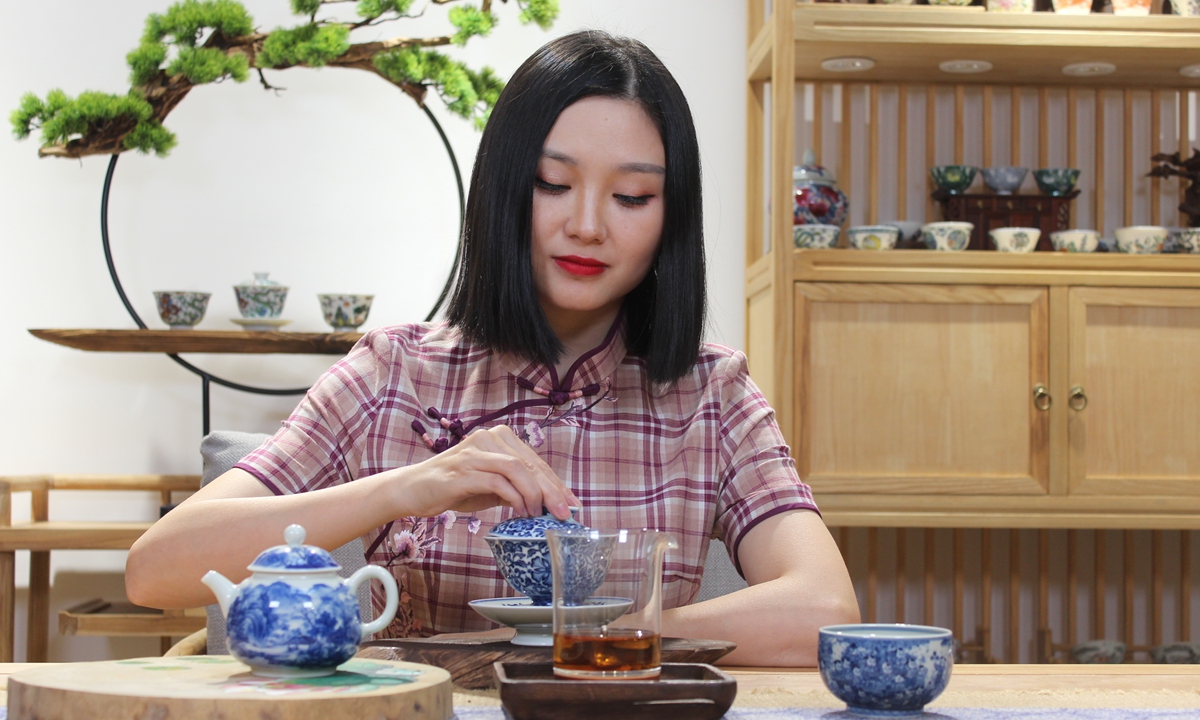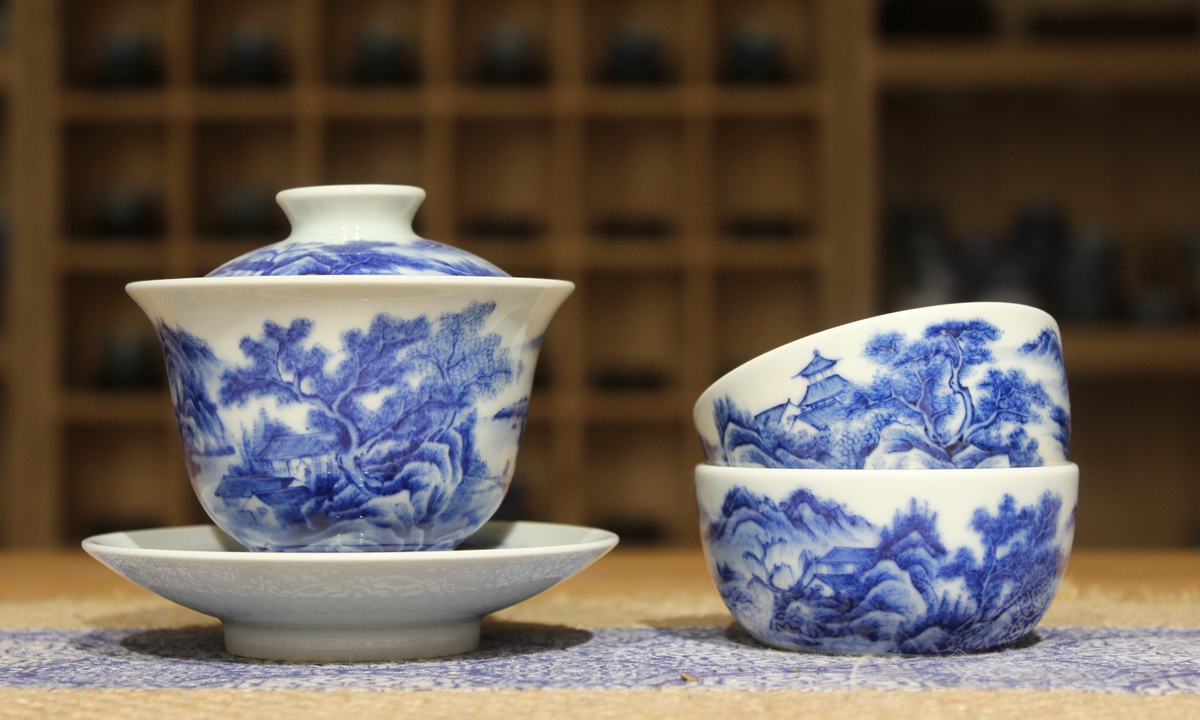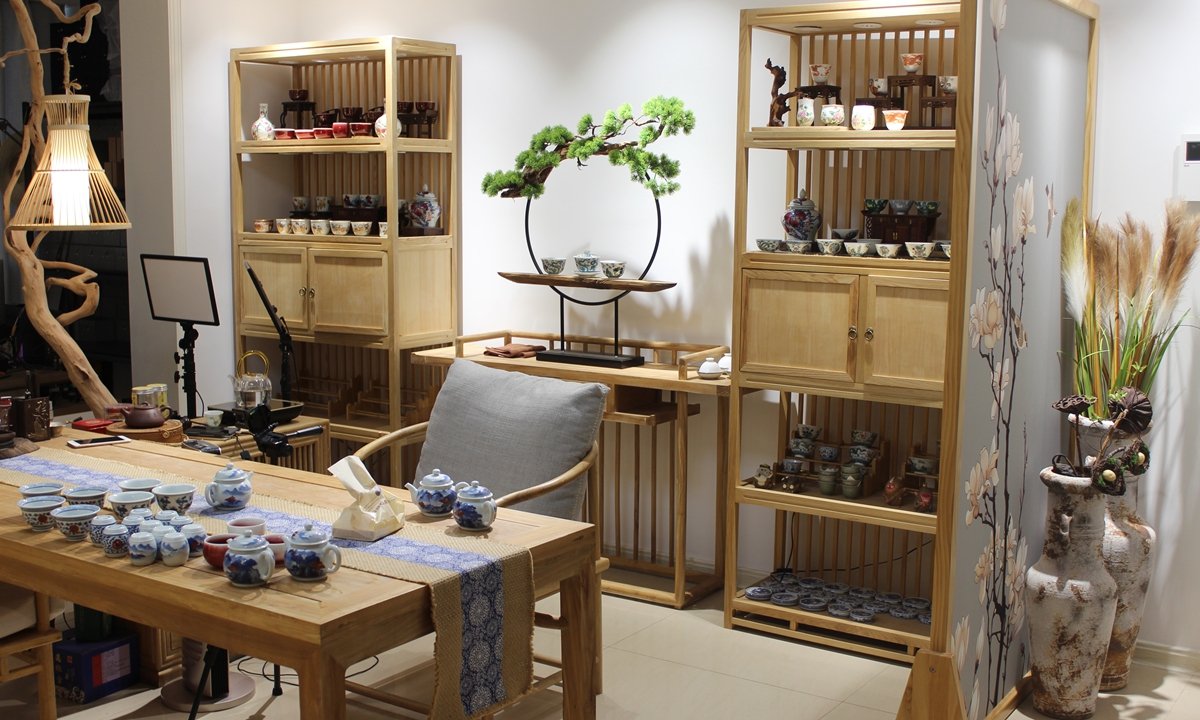Livestreaming helps chinaware find a new place
By Chen Xi Source: Global Times Published: 2020/11/17 18:23:41

Vlogger and porcelain maker Ye Yun enjoys a cup of tea. Photo: Courtesy of Ye Yun
Two years ago, 31-year-old Ye Yun was worried about whether her porcelain shop in China's well-known "Porcelain Capital" Jingdezhen in East China's Jiangxi Province would be able to survive. At the time, she never thought that just two years later the power of the internet would allow her to bring in 100,000 yuan ($15,100) a month.
"I was always very thankful to get one or two orders a day after I opened my physical store. I never imagined that I'd be getting 50 orders a day sometimes after opening a Kuaisou account," Ye said, talking with the Global Times about her success on Kuaisou, a Chinese video-sharing platform similar to TikTok.

Blue and white porcelain teacups Photo: Courtesy of Ye Yun
Following a passion
Born and raised in Jingdezhen, Ye was deeply influenced by the city's historical connection to one particular aspect of traditional Chinese culture - porcelain.
"I have an affection for painting on chinaware," she said.
Following her passion, Ye decided to attend the Jingdezhen Ceramic Institute. During her four years at the college, she joined a campus organization and worked as a student reporter whose main focus was interviewing the many famous master craftsmen in the city, which helped her establish a lot of connections for her later career.
After graduation, Ye continued reporting on the porcelain industry in the city. While she enjoyed her job, after six years, she finally decided to enter the industry herself by opening a porcelain shop.
"It is a lucky thing to work in your area of interest," Ye said.
However, she did not realize at the time that the road she chose would be full of challenges.
Ye quickly found out that sales were not very stable since her business was highly dependent on the local tourism industry, which was very seasonal. By accident one day, she saw a cattery host using Kuaishou to host a livestream, and came up the idea of using the app to promote her shop.
The results were far beyond anything she could have imagined as her account reached 22,000 followers within a short time.
"There can be 50 or 60 people in my live broadcast room at a time. At their best, monthly sales can reach several hundred thousand yuan," Ye said excitedly.
The move online ended up changing Ye's view of the world.

Ye Yun's studio in Jingdezhen, East China's Jiangxi Province Photo: Courtesy of Ye Yun
Behind the scenes
Over the next two years, Ye became one of the first vloggers in Jingdezhen.
At first, Ye only made some short videos about the ceramic products themselves, but she realized that was not enough. She wanted to reveal the cumbersome process used to make these products to customers so they could understand how difficult it was to make these delicate items. So she began uploading behind-the-scenes videos of how ceramics were made in ancient times.
"When they hold the chinaware in their hands, they can appreciate its preciousness even more," she explained.
Some of her more popular videos show the process of how Chai ware porcelains were made.
According to historical records, Chai wares were first made during the Five Dynasties (907-960) period at the Chai Kiln near today's Zhengzhou in Henan Province. Compared with other types of porcelain, Chai porcelain looks soft and sleek.
According to Ye, this type of porcelain can be difficult to make since production can be influenced by factors such as local weather conditions and the type of wood used. Ye said the whole process of firing the ceramics can take 26 hours and is very complicated. During this time, the craftsman in charge cannot sleep as he needs to monitor the fire and manually control the temperature by adding or reducing the amount of wood in the kiln.
This high level of difficulty can often make experimentation costly. Ye explained that she went through three batches of porcelain one time while trying to make a new glaze color, which ended up costing her 100,000 yuan. While costly, Ye said she was able to gain more experience through these failures.
A big dream
Since her family had no background in making porcelain, Ye couldn't rely on secret techniques passed down from generation to generation like some other kilns. It also means that she has to shoulder all the work in and outside the studio.
Currently, Ye has her own workshop with a team of 20 or 30 people.
Gradually, Ye began to create more mid-to-high-end wares based on her own creative impulses, independently designing and firing beautiful blue and white porcelains. According to Ye, her current goal is to release two to 10 new products every month.
Currently, about 80 percent of her viewers and customers are 30 to 40 years old. Ye noted that she hopes to attract more younger customers in the future.
With this goal in mind, she has started producing porcelains based popular cartoon characters or cute yellow ducks, which have been warmly welcomed.
With the rise of social media, more and more small business owners like Ye are turning to vlogging as a means to promote cultural products.
Looking to the future, Ye said she has big dreams and hopes that she can one day become a true porcelain master who can introduce the charm of Chinese proclaim culture overseas.
"The culture of Chinese porcelain is an important part of the history of Chinese art and handicrafts, to the point that the word chinaware originated from the name of our country 'China.' It is something that surely needs to be passed down to future generations," Ye said.
Newspaper headline: Lighting a fire
Posted in: RELATIONSHIPS,CULTURE & LEISURE,ARTS FOCUS